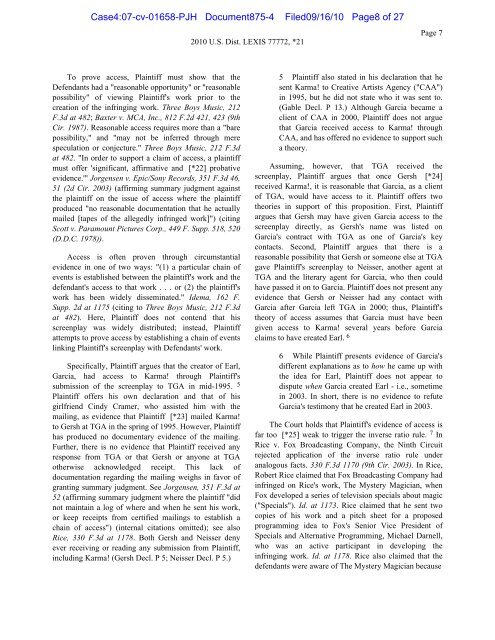exhibit 2 - SAP Lawsuit Portal
exhibit 2 - SAP Lawsuit Portal
exhibit 2 - SAP Lawsuit Portal
Create successful ePaper yourself
Turn your PDF publications into a flip-book with our unique Google optimized e-Paper software.
Case4:07-cv-01658-PJH Document875-4 Filed09/16/10 Page8 of 27<br />
To prove access, Plaintiff must show that the<br />
Defendants had a "reasonable opportunity" or "reasonable<br />
possibility" of viewing Plaintiff's work prior to the<br />
creation of the infringing work. Three Boys Music, 212<br />
F.3d at 482; Baxter v. MCA, Inc., 812 F.2d 421, 423 (9th<br />
Cir. 1987). Reasonable access requires more than a "bare<br />
possibility," and "may not be inferred through mere<br />
speculation or conjecture." Three Boys Music, 212 F.3d<br />
at 482. "In order to support a claim of access, a plaintiff<br />
must offer 'significant, affirmative and [*22] probative<br />
evidence.'" Jorgensen v. Epic/Sony Records, 351 F.3d 46,<br />
51 (2d Cir. 2003) (affirming summary judgment against<br />
the plaintiff on the issue of access where the plaintiff<br />
produced "no reasonable documentation that he actually<br />
mailed [tapes of the allegedly infringed work]") (citing<br />
Scott v. Paramount Pictures Corp., 449 F. Supp. 518, 520<br />
(D.D.C. 1978)).<br />
Access is often proven through circumstantial<br />
evidence in one of two ways: "(1) a particular chain of<br />
events is established between the plaintiff's work and the<br />
defendant's access to that work . . . or (2) the plaintiff's<br />
work has been widely disseminated." Idema, 162 F.<br />
Supp. 2d at 1175 (citing to Three Boys Music, 212 F.3d<br />
at 482). Here, Plaintiff does not contend that his<br />
screenplay was widely distributed; instead, Plaintiff<br />
attempts to prove access by establishing a chain of events<br />
linking Plaintiff's screenplay with Defendants' work.<br />
Specifically, Plaintiff argues that the creator of Earl,<br />
Garcia, had access to Karma! through Plaintiff's<br />
submission of the screenplay to TGA in mid-1995. 5<br />
Plaintiff offers his own declaration and that of his<br />
girlfriend Cindy Cramer, who assisted him with the<br />
mailing, as evidence that Plaintiff [*23] mailed Karma!<br />
to Gersh at TGA in the spring of 1995. However, Plaintiff<br />
has produced no documentary evidence of the mailing.<br />
Further, there is no evidence that Plaintiff received any<br />
response from TGA or that Gersh or anyone at TGA<br />
otherwise acknowledged receipt. This lack of<br />
documentation regarding the mailing weighs in favor of<br />
granting summary judgment. See Jorgensen, 351 F.3d at<br />
52 (affirming summary judgment where the plaintiff "did<br />
not maintain a log of where and when he sent his work,<br />
or keep receipts from certified mailings to establish a<br />
chain of access") (internal citations omitted); see also<br />
Rice, 330 F.3d at 1178. Both Gersh and Neisser deny<br />
ever receiving or reading any submission from Plaintiff,<br />
including Karma! (Gersh Decl. P 5; Neisser Decl. P 5.)<br />
2010 U.S. Dist. LEXIS 77772, *21<br />
Page 7<br />
5 Plaintiff also stated in his declaration that he<br />
sent Karma! to Creative Artists Agency ("CAA")<br />
in 1995, but he did not state who it was sent to.<br />
(Gable Decl. P 13.) Although Garcia became a<br />
client of CAA in 2000, Plaintiff does not argue<br />
that Garcia received access to Karma! through<br />
CAA, and has offered no evidence to support such<br />
a theory.<br />
Assuming, however, that TGA received the<br />
screenplay, Plaintiff argues that once Gersh [*24]<br />
received Karma!, it is reasonable that Garcia, as a client<br />
of TGA, would have access to it. Plaintiff offers two<br />
theories in support of this proposition. First, Plaintiff<br />
argues that Gersh may have given Garcia access to the<br />
screenplay directly, as Gersh's name was listed on<br />
Garcia's contract with TGA as one of Garcia's key<br />
contacts. Second, Plaintiff argues that there is a<br />
reasonable possibility that Gersh or someone else at TGA<br />
gave Plaintiff's screenplay to Neisser, another agent at<br />
TGA and the literary agent for Garcia, who then could<br />
have passed it on to Garcia. Plaintiff does not present any<br />
evidence that Gersh or Neisser had any contact with<br />
Garcia after Garcia left TGA in 2000; thus, Plaintiff's<br />
theory of access assumes that Garcia must have been<br />
given access to Karma! several years before Garcia<br />
claims to have created Earl. 6<br />
6 While Plaintiff presents evidence of Garcia's<br />
different explanations as to how he came up with<br />
the idea for Earl, Plaintiff does not appear to<br />
dispute when Garcia created Earl - i.e., sometime<br />
in 2003. In short, there is no evidence to refute<br />
Garcia's testimony that he created Earl in 2003.<br />
The Court holds that Plaintiff's evidence of access is<br />
far too [*25] weak to trigger the inverse ratio rule. 7 In<br />
Rice v. Fox Broadcasting Company, the Ninth Circuit<br />
rejected application of the inverse ratio rule under<br />
analogous facts. 330 F.3d 1170 (9th Cir. 2003). In Rice,<br />
Robert Rice claimed that Fox Broadcasting Company had<br />
infringed on Rice's work, The Mystery Magician, when<br />
Fox developed a series of television specials about magic<br />
("Specials"). Id. at 1173. Rice claimed that he sent two<br />
copies of his work and a pitch sheet for a proposed<br />
programming idea to Fox's Senior Vice President of<br />
Specials and Alternative Programming, Michael Darnell,<br />
who was an active participant in developing the<br />
infringing work. Id. at 1178. Rice also claimed that the<br />
defendants were aware of The Mystery Magician because


